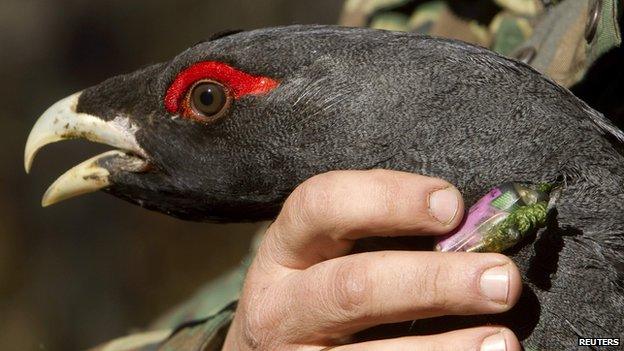Capercaillie: Scotland's unluckiest bird?
- Published

Capercaillie became extinct in Britain in the mid-18th century but were reintroduced almost a century later
Threatened by habitat loss, numerous predators and collisions with deer fences, capercaillie are said to be facing extinction in Scotland for a second time. Is this Scotland's unluckiest bird?
In Gaelic its name means great cock of the wood.
But there is nothing magnificent about the fortunes of the world's largest grouse.
According to the Scottish Gamekeepers Association (SGA), the bird is doomed to die out in Scotland.
The capercaillie is a native species that became extinct in Britain in the mid-18th century. The main cause for the extinction was thought to have been a catastrophic loss of its woodland habitat.
Birds from Sweden were reintroduced into Perthshire in 1837 and by the 1970s numbers of capercaillie had grown to about 20,000.
But numbers started crashing again and within 25 years the population had halved, according to Scottish Natural Heritage (SNH).
A survey carried out over 2003-2004 estimated there were about 1,980 individual birds left in Scotland.
The agency said the causes for this decline were varied.
They included further habitat loss, partly due to sheep and deer grazing on blaeberries, the juicy purple-blue fruit favoured by capercaillie.
Breeding females have increasingly fallen prey to crows, foxes and also poor summer weather.
Forestry operations and recreational pursuits in woodlands have also impacted on breeding birds.
Capercaillie have also been killed flying into high fences used to protect commercial forests from deer.
Few birds
More recent research has suggested that numbers have stabilised in the "core areas" of Deeside and Speyside. The birds are also found in upland Tayside.
This year capercaillie bred successfully for the first time in three years in woodland near Grantown-on-Spey.
Local residents were thanked for heeding advice on when and where to walk in Anagach Woods to avoid disturbing the birds.
However, over the summer, conservationists conceded defeat in their efforts to protect populations of capercaillie in the Trossachs and Argyll.
They said there were now only a few birds left and little or no breeding was taking place.
The SGA has now called for fresh action to protect capercaillie.
It has suggested trapping and relocating pine martens away from breeding areas in the Cairngorms. The organisation said removing the predator would help to halt a decline in numbers of the rare bird.
Allan Hodgson, of the SGA, said: "When it was suggested deer fences were the problem for capercaillie, they were removed quickly.
"When it was suggested habitat loss was the problem, lots of public money was ploughed into that.
"All of these things are important, as is weather, but it has taken those tasked with saving capercaillie far too long to act consistently on predation, despite warnings from practical land managers.
"It has been danced around for years at meetings because no one has been willing to get their hands dirty, fearful it may make them unpopular with their members."
But SNH said pine martens were also a protected species that required conservation efforts.
A spokesman said: "Pine martens are legally protected and we are pleased to see that this has contributed to their recovery from a real threat of extinction in Scotland.
"Where problems exist, a licence can be obtained to control them.
"Any licence application must, however, be able to demonstrate that pine marten predation, and not another factor, is suppressing the capercaillie population, and that removing them will improve the situation."
RSPB Scotland said it was too early to embark on a trial removal of pine martens.
Duncan Orr-Ewing, head of species and land management, said: "We agree that urgent action is required to help save capercaillie in Scotland, and the role of the pine marten must be considered as part of this.
"However, both species are scarce, and rightly receive a high level of protection under wildlife laws."
He added: "It is also hugely important to remember that in other countries, such as Sweden, capercaillie and pine marten live side by side, where predation occurs, and neither species is endangered.
"Bigger expanses of more connected forest are the most sustainable long term approach to securing the capercaillie's future, and much more needs to be done by all partners to help achieve this."
- Published27 September 2013
- Published17 September 2013
- Published9 July 2013
- Published4 July 2013